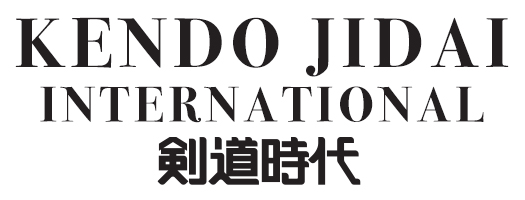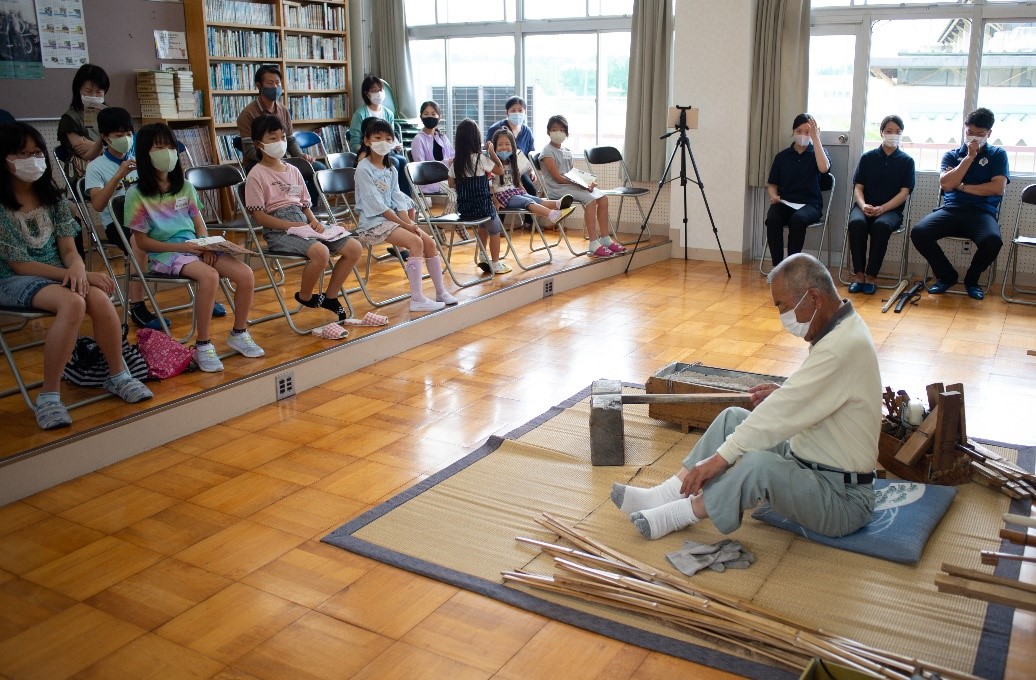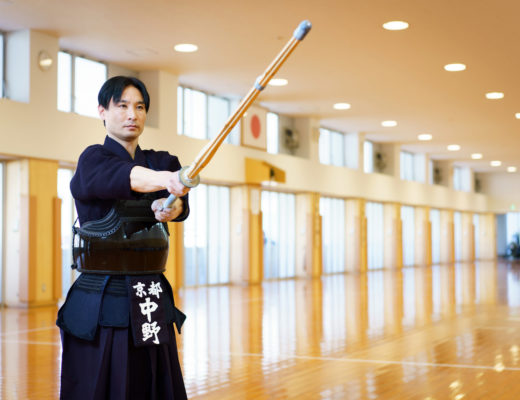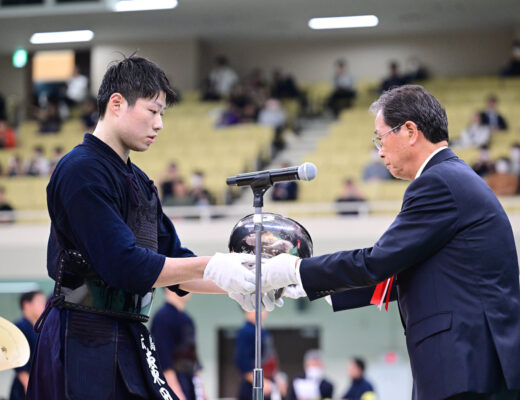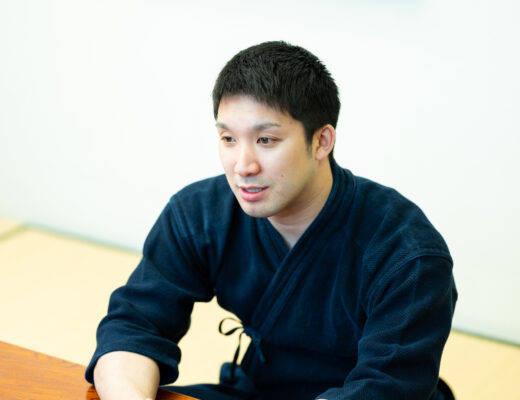In the 1960s, there was a community of Shinai craftsmen in the Higashikusano area of Maibara City, Shiga Prefecture. Many craftsmen lived there, and at its peak, Shinai from the region were even exhibited at major department stores in the Tokyo metropolitan area. This article features research by Sakamoto Taichi, who studies the history of Kendo techniques through the evolution of Kendo equipment and Shinai.
Sakamoto Taichi
Born in 1986. Kendo Renshi 6th Dan. Originally from Ibaraki Prefecture, he attended Toin Gakuen High School in Kanagawa Prefecture, before enrolling at Nippon Sport Science University. After completing his graduate studies at the same university, he started working at Gifu Pharmaceutical University, a municipal institution in Gifu Prefecture. Since 2017, he has served as the head coach of the Chubu Gakuin University Kendo Club.
****
I majored in Sport Culture and Social Science at the Graduate School of Nippon Sport Science University, where I studied sports history under Professor Tanigama Ryosho, the 11th president of the university. During my studies, Professor Tanigama advised me, “If you are going to continue practicing Kendo, you should research the history of Kendo techniques through the evolution of Kendo equipment and Shinai.” Following his guidance, I have continued my research in this field.
In June 2020, as part of this research, I visited the Isome family residence in Katata, Otsu City, Shiga Prefecture. The Isome family has preserved swordsmanship equipment and Shinai dating back to the late Edo period. These items were previously presented by Mitoma Yasuhisa, a high school teacher in Shiga Prefecture, at the 2009 annual conference of the Japanese Academy of Budo. On the day of the visit, I was accompanied by Mr. Mitoma, and together we measured and recorded the preserved items. After completing the survey, Mr. Mitoma recommended, “On your way back, you should stop by the Ibukiyama Cultural Museum in Maibara City, where Shinai are also on display.”
When I asked Mr. Takahashi, the curator of the museum, whether there were any historical materials related to Shinai, I learned that there used to be a community of Shinai craftsmen in the Higashikusano area of Maibara City. I hope that through the publication of this article, more people will come to know that many Shinai craftsmen once lived in the Ibukiyama region of Shiga Prefecture.
*Note: The Isome family served as prominent local officials and maritime transport leaders on Lake Biwa since the medieval period.
Shinai Craftsmanship in the Higashikusano Region of Maibara, Shiga Prefecture
The Higashikusano area of Maibara City is located in the northeastern part of Shiga Prefecture, nestled within the mountainous Ibukiyama region. The Anegawa River, which flows into Lake Biwa, has carved out a richly forested valley, where four small villages—Kozuhara, Magotani, Koga, and Yoshitsuki—are scattered across the limited flatlands. In Higashikusano, the natural environment and the livelihoods of its residents have long influenced one another, giving rise to a distinctive local culture. In March 2015, this unique harmony between landscape and way of life was recognized when “The Mountain Village Landscape of Higashikusano” was designated as an Important Cultural Landscape by the Japanese government.
In Higashikusano, residents traditionally engaged in charcoal making during the summer months. In the winter, when the region was snowbound, they turned to crafts such as hemp weaving, millstone carving, and Shinai production. In archival materials held by the Shiga Prefectural Government, the following description is given about Shinai making:
“In the late Taisho era, a resident of Ibuki Town apprenticed with a craftsman in Kyoto and brought the technique back home. Eventually, around ten farming households in the Koga area of Ibuki Town began making Shinai. Production was temporarily halted at the end of World War II but resumed around 1963. In the Kozuhara district, some residents had learned the craft while working as apprentices before the war, and with the postwar spread of Kendo, they gradually began producing Shinai alongside their agricultural work.”
The Ibuki Town History: General History, Volume II (1992), particularly the chapter titled “The Development of Villages,” provides a detailed account of the individuals who helped spread Shinai making and how it evolved into a local industry.
*Note: In February 2005, Ibuki Town was merged into Maibara City and no longer exists as an independent municipality.
“Shinai production in the Koga area was initiated by Ikeda Kuemon (then 90 years old) and his son Masataro. After training in Fukakusa, Kyoto, Ikeda returned to his hometown following the Russo-Japanese War and devoted himself to crafting Shinai. By around 1939–1940, demand had increased, and the work became a more stable source of income than charcoal production. Although production was temporarily halted at the end of World War II, it soon resumed. With the reinstatement of Kendo in junior and senior high schools, demand began to rise rapidly after 1955 and reached its peak in the early 1960s. The number of producers gradually increased, and makers also emerged in the Kozuhara area. In addition to the five households and twelve individuals producing Shinai in Koga, more than three households began production in Kozuhara, and there were times when supply could not keep up with demand.”
From the two sources mentioned above, it is clear that Shinai production began in the Koga area of Ibuki Town in the late Taisho era and later spread to Kozuhara. Before and during World War II, Shinai were supplied to the military. After the war, demand expanded due to the reintroduction of Kendo in educational settings, leading to a gradual increase in the number of Shinai craftsmen. A report compiled by the Maibara City Board of Education in 2019 provides a detailed account of Shinai production at its peak.
While some of the bamboo used for Shinai production was locally sourced, bamboo was scarce in the Koga area, so most materials were procured from bamboo wholesalers in Kyoto. A standard bundle for producing ten Shinai required forty bamboo slats, and materials were ordered in lots of a thousand or more, delivered by truck. Some craftsmen also sourced bamboo from Takashima District in Shiga Prefecture, known for producing fan ribs and rich in bamboo resources.
Shinai were made year-round, but the busiest period was April and May, coinciding with the start of the new school year. During peak times, craftsmen could complete up to ten Shinai in a single day. However, due to the time-consuming work of organizing and sun-drying the bamboo, the annual production capacity was around 2,400 Shinai. Work typically took place from 7 a.m. to 7 p.m. in a six-tatami-mat (9.72 square meters) room next to the entrance. Women were generally involved only in removing the bamboo nodes—a task called Fushi-oroshi. Most of the completed Shinai were intended for use in school physical education classes, while higher-quality materials were selected for Shinai used by advanced practitioners.
Although Shinai production had become a stable source of income, around 1970, a nationwide phenomenon of bamboo flowering and withering led to a shortage of suitable materials. As a result, Shinai distributors were forced to shift production overseas. According to The Ibuki Town History: General History, Volume II, “From the late 1960s, inexpensive imported Shinai from Taiwan and Korea began to circulate, leading to a gradual decline in demand for domestically produced practice Shinai. Although there were occasional special orders from instructors or training halls, both the quantity and quality of orders decreased, making it difficult for craftsmen to sustain their livelihoods. One by one, the local producers disappeared.”
In other words, efforts to overcome the material shortage inadvertently opened the door to cheaper overseas products, which in turn hastened the decline of the Shinai-making industry in Higashikusano.
In September 2016, the Maibara City Board of Education and the research laboratory of Professor Ichikawa Hideyuki from the School of Human Cultures at the University of Shiga Prefecture collected approximately 200 tools and materials related to Shinai production from a traditional house in the Koga area of Maibara City. On February 16, 2021, this collection was officially designated as a Tangible Folk Cultural Property by Shiga Prefecture and is now preserved by the Maibara City Board of Education.
When I asked Mr. Takahashi, the museum curator, whether I could conduct research on Shinai production in the area, he responded enthusiastically, saying, “We’ve been waiting for someone like you!” As I continued my inquiries, I learned that a former Shinai craftsman, Mr. Ikeda Mitsunobu, still lived in Koga. Arrangements were made for me to meet him on a later date.
In the course of this investigation, I searched for previous studies on Shinai production in the region and came across a graduation thesis by Ibayashi Mano (née Chikaraishi) from the University of Shiga Prefecture, titled A Study on the Historical Development of Domestic Shinai Production Based on the Life Histories of Shinai Craftsmen: Focusing on Shiga Prefecture (2011). This research sheds light on the historical evolution of the Shinai-making industry rooted in Shiga Prefecture through the life histories of two craftsmen: Mr. Yamaguchi Yoshiaki, who worked under the Shinai brand name “Hiei,” and Mr. Ikeda Mitsunobu, a former craftsman whose brand was “Yukimitsu.”
In the following section, I would like to introduce the work and craft of Mr. Ikeda, a former Shinai maker from Koga, drawing on both Ibayashi’s research and the interviews I conducted with Mr. Ikeda himself. I have obtained permission from Ms. Ibayashi to reference and publish her research findings in this article.
Ikeda Mitsunobu: The Last Shinai Craftsman of Koga
The rest of this article is only available for Kendo Jidai International subscribers!
